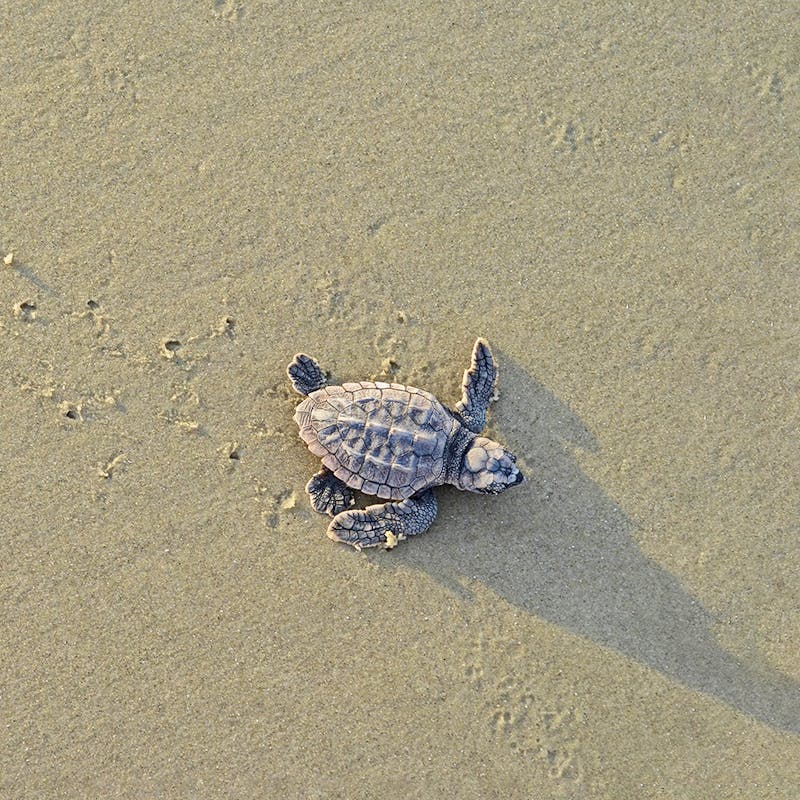World Sea Turtle Day
World Sea Turtle Day is celebrated annually on June 16 to honor Dr. Archie Carr, Jr., a pioneering conservationist and herpetologist who drew national and international attention to the plight of sea turtles and the risks of extinction. Much of what is known about the biology and life cycles of sea turtles can be credited to Dr. Carr’s research, teaching and writing. In 1991, the Archie Carr National Wildlife Refuge was established along 20.5 miles of Florida’s central east coast to protect sea turtles and their habitat. Since then, local, state and federal partnerships have helped to protect and rebuild one of the most productive sea turtle nesting sites in the world.
This World Sea Turtle Day, sea turtle nesting is well underway in the southeastern United States, where area beaches and waters are globally and regionally significant for sea turtles. Five of the world’s seven species of sea turtles are found in the Southeast: loggerhead, leatherback, green, Kemp’s ridley, and hawksbill, and each of these is listed as threatened or endangered by the Endangered Species Act. Florida is home to 90% of sea turtle nesting in the continental United States, and together with beaches in Georgia, South Carolina and North Carolina, supports the largest aggregation of nesting loggerhead sea turtles in the world. The majority of loggerhead nesting in the Southeast takes place on Florida’s Atlantic coast, especially within the Archie Carr National Wildlife Refuge; 91,451 loggerhead nests were counted in Florida during the 2018 nesting season. Florida beaches also provide the second-largest nesting area for green sea turtles in the wider Caribbean and nesting has been on the rise — in 2017, biologists documented a record of more than 53,000 green turtle nests on Florida beaches; greens are the latest nesters and will nest through September. Leatherbacks, which are nesting in increasing numbers in the region, are the earliest nesters and begin coming ashore on the central and southeastern coast of Florida in February and March. Kemp’s ridleys and hawksbills utilize area waters and occasionally nest on regional beaches.
Protection afforded to sea turtles through the Endangered Species Act helped reverse population declines and we have seen an increase in nesting in the region over the years. At the same time, many threats remain in the Southeast. Fisheries bycatch, habitat loss and disturbance due to development, oil spills and other pollution, ingestion of plastics, entanglement in marine debris, artificial lighting, beach armoring and illegal harvesting are all negatively impacting sea turtle populations across the oceans. Climate change also threatens sea turtles as rising sea levels inundate nesting beaches and warming sands shift the sex ratio of hatchlings.
Despite these threats, things are looking up for sea turtles in the Southeast this year. In Florida, Georgia, and South Carolina, sea turtles began nesting early and some even nested in a few new places. In Florida, a rare Kemp’s ridley nested in Clearwater and four leatherbacks nested in the Sarasota area; in South Carolina, a Kemp’s ridley nested on Hilton Head. Georgia is also reporting that it could be a record year, with 1,799 nests already documented this season. All three states are reporting larger than usual numbers of nesting turtles so far in the nesting season, which is expected to peak in late June/July. While current trends are positive, the nesting season is not over and with the possibility that hurricanes or harmful algal blooms that may occur over the next few months, sea turtle advocates are cautiously optimistic that this will be a successful year.
Sea turtles are beloved around the world, and here in the Southeast we have an exceptional appreciation for these magnificent creatures. While Defenders is working to defend the Southeast’s coasts from offshore oil and gas drilling, to protect coastal habitat from development, and to stand up for environmental laws like the Endangered Species Act, individuals can contribute to protecting and conserving these ancient marine reptiles as well.
Thankfully, there a number of things you can do to increase the odds for sea turtles, whether you live in a beachside community or are just visiting:
-
- Keep the beach clean! Pick up litter, toys, chairs, umbrellas, boats and other items at night. If left on the beach, these can be major obstacles to nesting females and hatchlings. Likewise, fill in any holes made during your visit to the beach. Remove any food or unsecured trash that can attract raccoons and other predators that eat eggs and hatchlings.
- Leave sea turtles and their nests alone. If you spot a sea turtle — an adult or a hatchling — feel free to take photos (don’t use flash) or watch them move along from a distance. But don’t get in their way, and don’t handle them — they need to focus on getting to the water. Plus, it’s illegal! If you see a nest (marked or otherwise) be sure to give it plenty of space.
- If you find a sick, injured or dead sea turtle, in Florida, call 1–888–404-FWCC; in GA, call DNR at 800–2-SAVE-ME (800–272–8363); in SC call 1–800–922–5431; in NC call the NC Sea Turtle Hotline at 252–241–7367.
- Choose seafood caught in ways that do not harm or kill sea turtles. Check out www.seafoodwatch.com.
- Volunteer! Organize or join a beach cleanup with schools, scouts or community organizations. Take part in a beach patrol monitoring the nesting sites and hatching progress.
Save these tips, share them, and print them out and hang them on your fridge! - Cut back on fertilizers and pesticides! Most water ends up in the ocean at some point, and it carries all our human pollutants and toxins with it. Fertilizer runoff is linked to blooms of harmful algae and low oxygen in coastal areas, which can sicken or kill marine life, including turtles and their food.
- Just say NO to plastic! Every year, millions of tons of plastic finds its way to our oceans. Plastic is often ingested, and sea turtles can become entangled in trash, potentially leading to a slow death. Opt for paper or other reusable packaging. Don’t release helium balloons which can be mistaken for food.
- Avoid driving on the beach at night (or at all)! Driving compacts the sand and creates ruts that can trap hatchlings, headlights can confuse nesting females or hatchlings and drivers risk hitting females or running over nests or hatchlings.
- Watch out for sea turtles while boating. Sea turtles need to surface to breathe and can be hard to see.
Fortunately, sea turtles have many allies around the world and sea turtle conservation is truly a global effort. It is remarkable and heartening to know that many thousands of volunteers are committed to helping sea turtles wherever they occur. People the world over volunteer their time to mark nests or pick up trash on beaches, we can all speak up against dangerous offshore drilling and we can advocate for alternatives to plastic. Sea turtles have been around for more than 110 million years and we must continue to work together to ensure that they are able to live on into the future.















Follow Defenders of Wildlife
facebook bluesky twitter instagram youtube tiktok threads linkedin